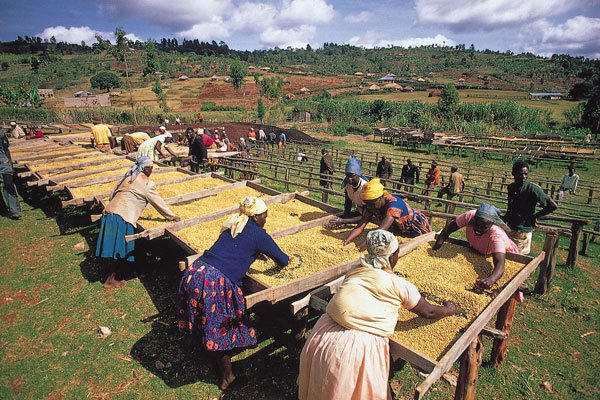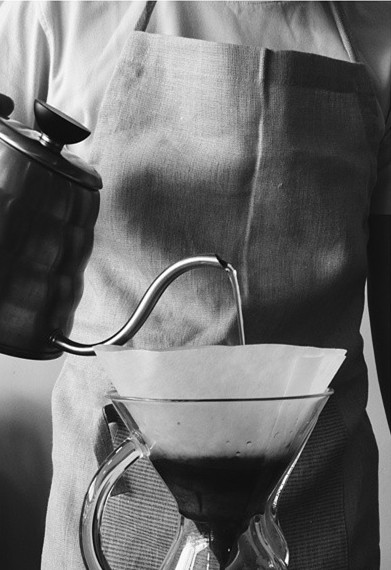Kenya coffee treatment method Kenya coffee grade classification Kenya coffee taste suitable for iced coffee drink
Kenyan coffee processing
Large farms usually have independent treatment facilities. A large number of small farmers usually pick ripe coffee fruits by hand. Coffee picking is a labor-intensive job that requires the whole family to deploy and even hire workers during the harvest season. The fresh fruit of the picked coffee needs to be delivered in time to the cooperative-owned coffee processing plant for pulping, which may be carried by ox carts, pick-up trucks or trucks. After peeling, Parchmentcoffee is briefly kept in the cooperative's processing plant and sent to a privately owned factory for shelling treatment.
Kenyan coffee grade
Kenya is a well-known producer based on the size of coffee beans. It is usually divided into nine grades, according to the bean type, there are PB (round beans, accounting for about 10% of the total output), in addition, there are E (elephant beans), AA, AB, C, T, TT, MH, ML according to size. The best coffee grade is bean-shaped berry coffee PB, followed by AA++, AA+, AA, AB and so on.
Usually Kenyan coffee is classified as follows:
1) Common categories:
Hand-picked coffee fruit, picked by hand, picked out immature fruit (unripe), overripe fruit (overripe) and other defects, peeled, after about 36 hours of fermentation, placed on a metal grid for sun drying, in the processing plant to remove the seed shell (parchment), become a blue-green appearance of attractive Kenyan raw beans.
These beautiful raw beans are graded according to particle size (size), shape (shape) and weight (weight):
E:kenyaE, elephant beans, elephantbean,18 and above (including round beans)
AA:KenyaAA,17-18 mesh
AB:KenyaAB,15-16, which is a mixture of An and B.
Light beans selected by TT:AA and AB by airflow separator
Above PB:KenyaPB,15, round bean
CRV 12-14 mesh and PB light bean screened by air flow separator
Under 12 eyes, there are more defective beans, chopped beans and light beans.
HE: beyond the above level becomes HE (HulledEars)
2) the raw beans without official standard grading are UG (ungrade).
E,AA,AB,PB → UG1
C,TT,T,HE → UG2
(note: class An over 17 mesh (6.8mm), class B over 16 mesh (6.3mm) 18 mesh = 18cm 64 inches, 1 inch = 25.4mm)
Taste
Kenyan coffee has an irresistible aroma, and the best Kenyan coffee has strong acidity, reminiscent of ripe blackcurrants, oranges or cherries. At the same time, Kenya coffee has a strong raspberry aroma, such as blueberry, often with rose fruit, passion fruit and floral aroma, with a BlackBerry and grapefruit flavor, is a favorite of many coffee glutton.
This coffee has an excellent medium purity, crisp and refreshing taste. It has a fresh flavor and is most suitable for drinking iced coffee in summer. When tasting this coffee, if it is paired with sour fruits such as grapefruit, it will certainly give you the best coffee experience.
Recommended item [KenyaNyeriGatugiAA]
Country: Kenya
Grade: AA
Production area: Nyeri Central Dashan area
Altitude: 1600-2300 m
Soil quality: volcanic clay
Treatment: washing
Baking: medium and shallow
Variety: SL28,SL34
Processing plant: Gatugi processing plant
Producer: small coffee farmers
Flavor: floral aroma, blackcurrant, cranberry

Important Notice :
前街咖啡 FrontStreet Coffee has moved to new addredd:
FrontStreet Coffee Address: 315,Donghua East Road,GuangZhou
Tel:020 38364473
- Prev

Kenyan Coffee Kenya kenya Coffee Manor Kenyan Coffee varieties Kenyan Coffee growing area
Kenyan coffee has many followers in the boutique coffee industry, and Kenyan AA has an extraordinary popularity. Kenyan coffee, known as the Cup of connoisseurs (ConnoisseursCup), is famous in the coffee industry for its rich aroma, bright and vibrant acidity, full and elegant mellowness and red wine flavor. Caffeine in different producing areas has its own fine due to the difference of microclimate.
- Next

What are the effects of the opponent making coffee? What are the effects of the extraction of hand coffee?
Today we are going to do an experiment to test what affects the taste of hand-brewed coffee. Both groups are soaked coffee with the same coffee beans, and the extraction time is two minutes. The first is stirring soaking, and the second group is static soaking. The first group was counterclockwise one minute before, and then poured the coffee into the v60, while the second group was stationary but stirred in the last ten seconds.
Related
- Detailed explanation of Jadeite planting Land in Panamanian Jadeite Manor introduction to the grading system of Jadeite competitive bidding, Red bid, Green bid and Rose Summer
- Story of Coffee planting in Brenka region of Costa Rica Stonehenge Manor anaerobic heavy honey treatment of flavor mouth
- What's on the barrel of Blue Mountain Coffee beans?
- Can American coffee also pull flowers? How to use hot American style to pull out a good-looking pattern?
- Can you make a cold extract with coffee beans? What is the right proportion for cold-extracted coffee formula?
- Indonesian PWN Gold Mandrine Coffee Origin Features Flavor How to Chong? Mandolin coffee is American.
- A brief introduction to the flavor characteristics of Brazilian yellow bourbon coffee beans
- What is the effect of different water quality on the flavor of cold-extracted coffee? What kind of water is best for brewing coffee?
- Why do you think of Rose Summer whenever you mention Panamanian coffee?
- Introduction to the characteristics of authentic blue mountain coffee bean producing areas? What is the CIB Coffee Authority in Jamaica?

